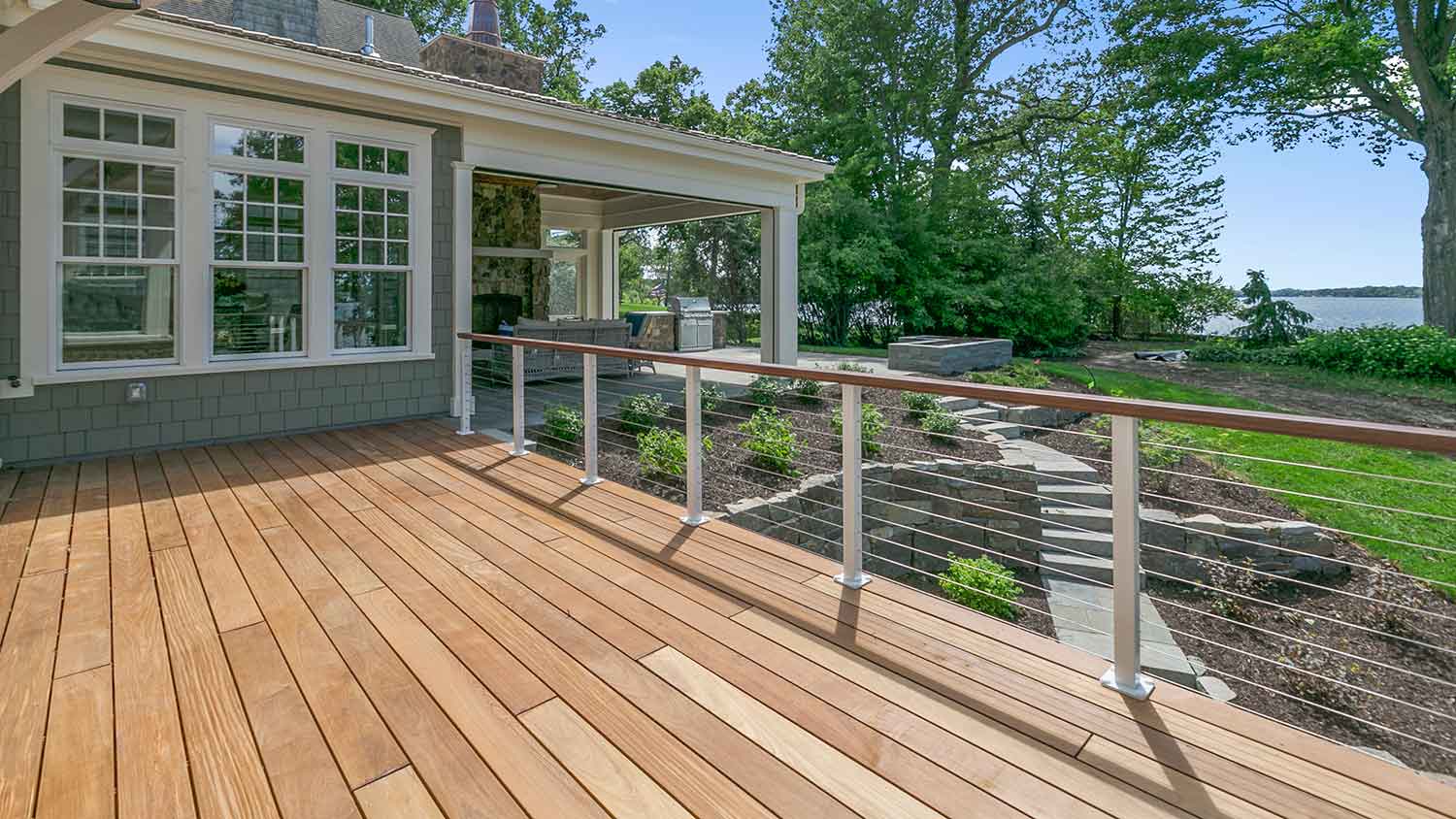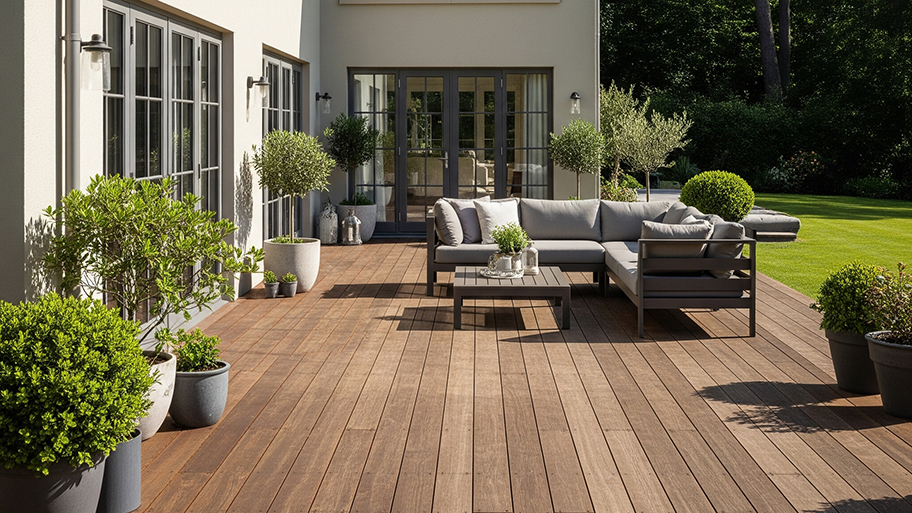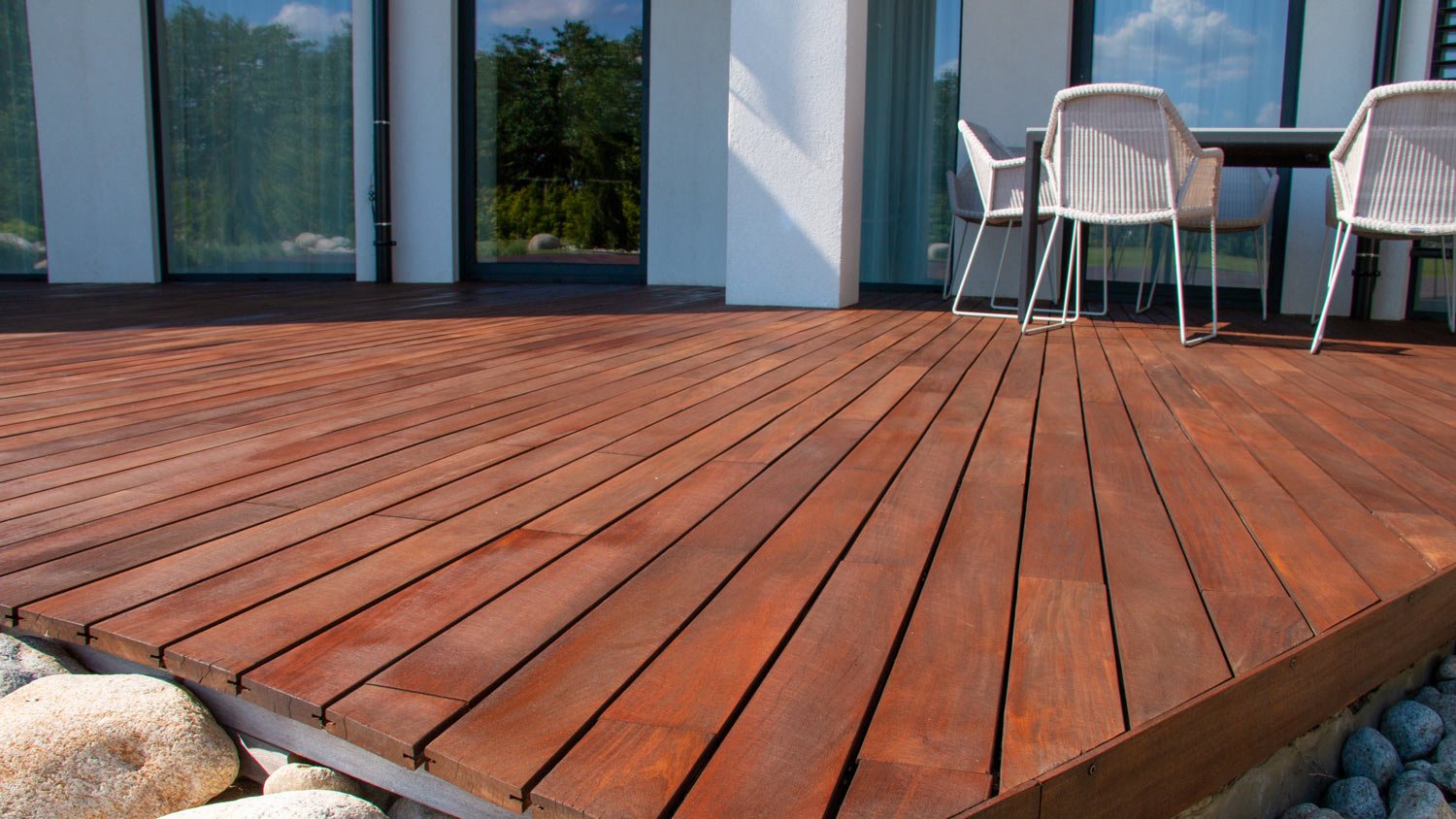
Sealing a deck is important for protecting it against the elements. Find out the cost to seal a deck, whether you DIY or hire a pro to do the job.
Get familiar with these deck terms before you start a staining project


Calling all soon-to-be deck experts! You need to know the slang before you slap on that first coat of deck stain. A staining project creates the perfect opportunity to run through your deck maintenance checklist. Take a look at the key terms for deck maintenance to have in your DIY vocabulary before staining a deck yourself.

The first term on our list is the beam, an essential component of your deck.
Beams support your deck to keep it safe and attractive. Acting as a support structure for your deck joists, a beam runs parallel to your ledger across your posts. Check for large cracks, water damage, or separation from posts or piers whenever you inspect your deck.
While you may assume that staining beams isn't necessary because they aren't visible, it's important to remember stain isn't just for aesthetic purposes. It protects wood from sun damage, moisture issues, and other common deck problems. Consider your deck's positioning in relation to UV rays when deciding whether or not to stain beams.
You'll probably need both when managing broad surfaces and small details while applying stain and sealant.

Considering some board replacements when redoing your deck? Composite decking is a popular option that combines recycled plastics and wood fibers for a low-maintenance deck.
Decking refers to the actual floorboards that you walk on when using your deck. Maintenance goes beyond just making sure the finish looks pristine. Do regular inspections to check for warping and separating. Compromised decking could cause someone to step right through the bottom of your deck!
Put this one on your list for the next trip to the hardware store. These large, inexpensive sheets can protect the surrounding area from spills and splatters while you stain, making it an important deck term to know.

Homeowners should be keenly aware of the state of all fasteners. These are the nails, screws, and anchors that are holding everything together. Replace or restore any rusted or loose fasteners.
Flashing actually covers two different things in the world of decks. First, contractors refer to any area where stain has been applied inconsistently or unevenly as an area of "flashing." You have flashing if you're noticing different thickness levels on your deck's finish.
The second usage refers to the metal or plastic guards that are placed where the deck meets the house. Flashing is essential for preventing moisture issues and rot! It helps to direct water away from your house.

Have you ever wondered if you could have a deck without having it attach to your house? The term is called a floating deck. Floating decks sit low to the ground with special suspension support.
Your deck's footing is the underground support provided for the deck post. Just look for the concrete block to find it.

Joists are the repeated horizontal boards that essentially make up your deck frame. Joints need extra attention in your maintenance plan due to the fact that they will compromise your deck's strength if they begin to rot.
Find your ledger board right where your deck attaches to your home. Ensure that your ledger board is fastened using bolts or lag screws instead of nails if you've inherited a deck from a previous owner.
Nails are less capable of handling the vertical and lateral loads caused by weight and movement on a deck. Keeping nails puts your deck at risk for bent or pulled sheathing and joists.

Posts make up the vertical frame support for beams and joists.
Start with a clean deck if you're straining your deck this year. Contractors highly recommended pressure washing to rid your deck of dirt, grime, pollen, and stains. However, pressure washing properly requires a delicate balance.
Pressure washing that is too powerful can actually splinter the wood on your deck. You must also allow your deck to dry fully after a pressure washing before staining. Consider hiring a professional to power wash your deck if the task is intimidating.

Offering both beauty and security, deck railings are barriers with horizontal vertical beams that finish off a deck.
If your deck has steps, the risers are the vertical boards that support the stairs.
Deck sealer creates a transparent coat that's intended to seep into your wood for a clear seal that protects your wood's finish. Sealing a deck helps to lock out moisture from rain and snow that can cause rot.
Most sealers are intended to be applied after staining. However, skipping staining to use a clear sealant that shows off the natural look of a wood deck is an option. All-in-one products combining sealant and stain can offer protection while reducing the time spent finishing your deck.

Stain isn't just "deck paint." Stains are made to be durable enough to prevent chipping and cracking that easily happen on a high-traffic deck.
You'll see these options when shopping for deck stain:
Water-based semi-transparent: Keeps natural grain visible
Oil-based semi-transparent: Keeps natural grain visible with increased protection
Water-based solid color: Paint-like look with UV protection
Oil-based solid: Deep color penetration
The last deck term on our list is wood cleaner. A deep clean done with deck wood cleaner should be done annually. Wood cleaner removes dirt and mildew for a like-new deck every season.
Here's what your annual deck cleaning should include:
Clear away the grill, furniture, and planters
Sweep any debris and dirt
Repair rotting, cracks, or splintering
Clear off furniture and planters
Wash deck with a cleaner for your deck material
Let dry
Refinish (optional)
Now that you know 18 essential deck terms, you can handle maintenance with confidence.
From average costs to expert advice, get all the answers you need to get your job done.

Sealing a deck is important for protecting it against the elements. Find out the cost to seal a deck, whether you DIY or hire a pro to do the job.

Finding maintenance-free decking that works for your home, budget, and lifestyle can be challenging. This guide lists the 7 best low-maintenance deck materials.

If your load-bearing porch post is starting to rot and deteriorate, you may wonder who to hire to replace porch columns. Let’s explore the project.

Left with a sticky mess instead of a beautifully stained wood project? Learn why your wood stain isn’t drying and how to fix the problem.

You can get even more years out of your cedar fence by giving it a little stain and TLC. Learn how to seal a cedar fence with this guide.

If you’re stuck wondering why your deck stain is peeling prematurely, use this guide to troubleshoot the problem and find a long-lasting solution.